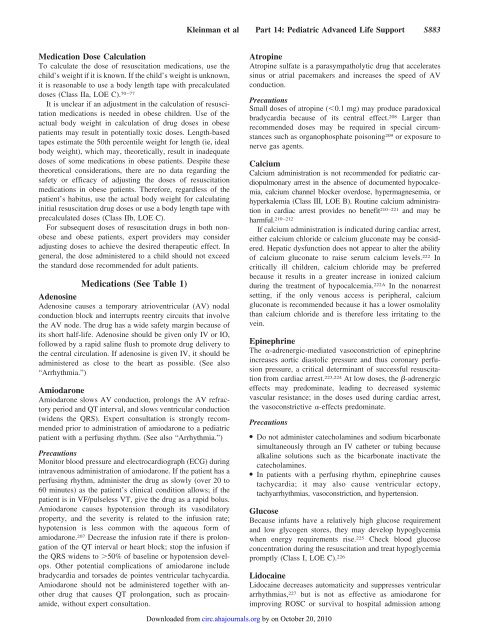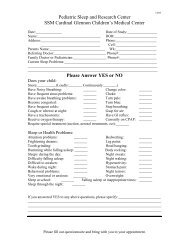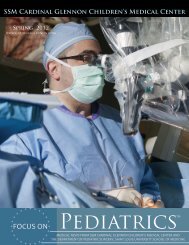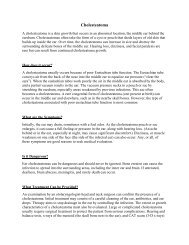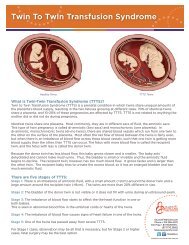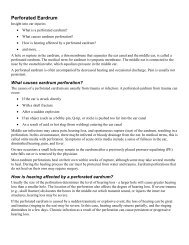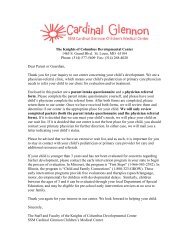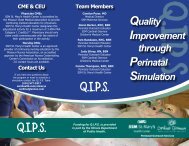pediatric-ALS-AHA-guidelines-circulation_11-2010 - SSM Cardinal ...
pediatric-ALS-AHA-guidelines-circulation_11-2010 - SSM Cardinal ...
pediatric-ALS-AHA-guidelines-circulation_11-2010 - SSM Cardinal ...
You also want an ePaper? Increase the reach of your titles
YUMPU automatically turns print PDFs into web optimized ePapers that Google loves.
Kleinman et al Part 14: Pediatric Advanced Life Support S883Medication Dose CalculationTo calculate the dose of resuscitation medications, use thechild’s weight if it is known. If the child’s weight is unknown,it is reasonable to use a body length tape with precalculateddoses (Class IIa, LOE C). 70–77It is unclear if an adjustment in the calculation of resuscitationmedications is needed in obese children. Use of theactual body weight in calculation of drug doses in obesepatients may result in potentially toxic doses. Length-basedtapes estimate the 50th percentile weight for length (ie, idealbody weight), which may, theoretically, result in inadequatedoses of some medications in obese patients. Despite thesetheoretical considerations, there are no data regarding thesafety or efficacy of adjusting the doses of resuscitationmedications in obese patients. Therefore, regardless of thepatient’s habitus, use the actual body weight for calculatinginitial resuscitation drug doses or use a body length tape withprecalculated doses (Class IIb, LOE C).For subsequent doses of resuscitation drugs in both nonobeseand obese patients, expert providers may consideradjusting doses to achieve the desired therapeutic effect. Ingeneral, the dose administered to a child should not exceedthe standard dose recommended for adult patients.Medications (See Table 1)AdenosineAdenosine causes a temporary atrioventricular (AV) nodalconduction block and interrupts reentry circuits that involvethe AV node. The drug has a wide safety margin because ofits short half-life. Adenosine should be given only IV or IO,followed by a rapid saline flush to promote drug delivery tothe central <strong>circulation</strong>. If adenosine is given IV, it should beadministered as close to the heart as possible. (See also“Arrhythmia.”)AmiodaroneAmiodarone slows AV conduction, prolongs the AV refractoryperiod and QT interval, and slows ventricular conduction(widens the QRS). Expert consultation is strongly recommendedprior to administration of amiodarone to a <strong>pediatric</strong>patient with a perfusing rhythm. (See also “Arrhythmia.”)PrecautionsMonitor blood pressure and electrocardiograph (ECG) duringintravenous administration of amiodarone. If the patient has aperfusing rhythm, administer the drug as slowly (over 20 to60 minutes) as the patient’s clinical condition allows; if thepatient is in VF/pulseless VT, give the drug as a rapid bolus.Amiodarone causes hypotension through its vasodilatoryproperty, and the severity is related to the infusion rate;hypotension is less common with the aqueous form ofamiodarone. 207 Decrease the infusion rate if there is prolongationof the QT interval or heart block; stop the infusion ifthe QRS widens to 50% of baseline or hypotension develops.Other potential complications of amiodarone includebradycardia and torsades de pointes ventricular tachycardia.Amiodarone should not be administered together with anotherdrug that causes QT prolongation, such as procainamide,without expert consultation.AtropineAtropine sulfate is a parasympatholytic drug that acceleratessinus or atrial pacemakers and increases the speed of AVconduction.PrecautionsSmall doses of atropine (0.1 mg) may produce paradoxicalbradycardia because of its central effect. 208 Larger thanrecommended doses may be required in special circumstancessuch as organophosphate poisoning 209 or exposure tonerve gas agents.CalciumCalcium administration is not recommended for <strong>pediatric</strong> cardiopulmonaryarrest in the absence of documented hypocalcemia,calcium channel blocker overdose, hypermagnesemia, orhyperkalemia (Class III, LOE B). Routine calcium administrationin cardiac arrest provides no benefit 210–221 and may beharmful. 210–212If calcium administration is indicated during cardiac arrest,either calcium chloride or calcium gluconate may be considered.Hepatic dysfunction does not appear to alter the abilityof calcium gluconate to raise serum calcium levels. 222 Incritically ill children, calcium chloride may be preferredbecause it results in a greater increase in ionized calciumduring the treatment of hypocalcemia. 222A In the nonarrestsetting, if the only venous access is peripheral, calciumgluconate is recommended because it has a lower osmolalitythan calcium chloride and is therefore less irritating to thevein.EpinephrineThe -adrenergic-mediated vasoconstriction of epinephrineincreases aortic diastolic pressure and thus coronary perfusionpressure, a critical determinant of successful resuscitationfrom cardiac arrest. 223,224 At low doses, the -adrenergiceffects may predominate, leading to decreased systemicvascular resistance; in the doses used during cardiac arrest,the vasoconstrictive -effects predominate.Precautions● Do not administer catecholamines and sodium bicarbonatesimultaneously through an IV catheter or tubing becausealkaline solutions such as the bicarbonate inactivate thecatecholamines.● In patients with a perfusing rhythm, epinephrine causestachycardia; it may also cause ventricular ectopy,tachyarrhythmias, vasoconstriction, and hypertension.GlucoseBecause infants have a relatively high glucose requirementand low glycogen stores, they may develop hypoglycemiawhen energy requirements rise. 225 Check blood glucoseconcentration during the resuscitation and treat hypoglycemiapromptly (Class I, LOE C). 226LidocaineLidocaine decreases automaticity and suppresses ventriculararrhythmias, 227 but is not as effective as amiodarone forimproving ROSC or survival to hospital admission amongDownloaded from circ.ahajournals.org by on October 20, <strong>2010</strong>


